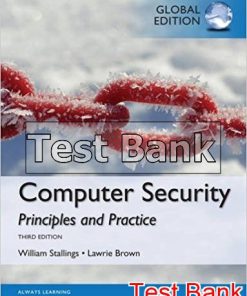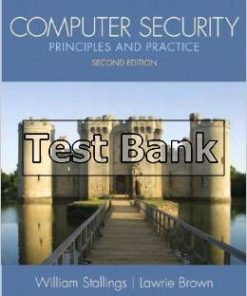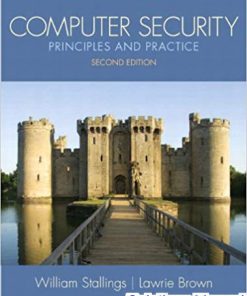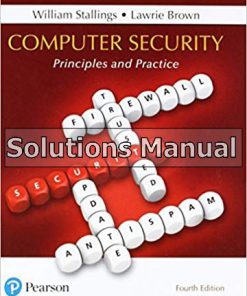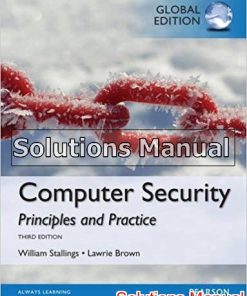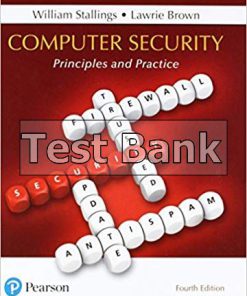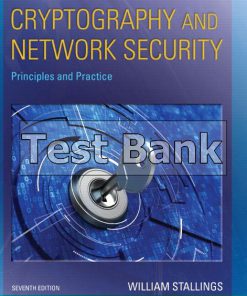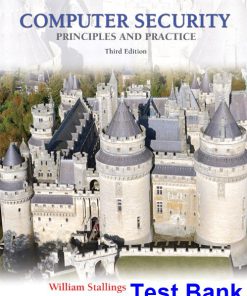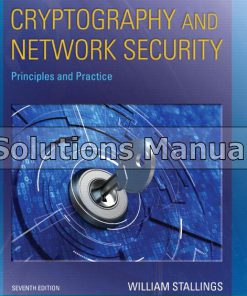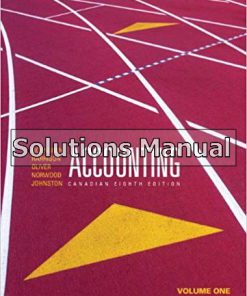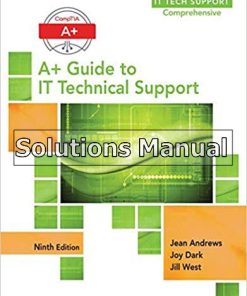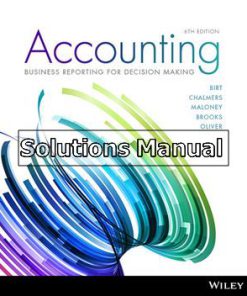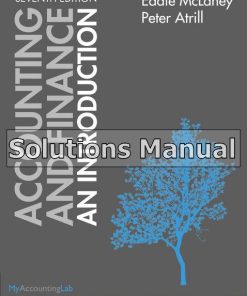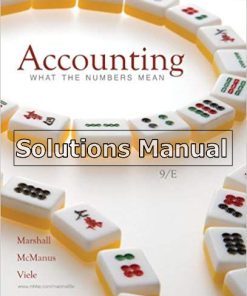Computer Security Principles and Practice 3rd Edition Stallings Solutions Manual
$50.00 Original price was: $50.00.$26.50Current price is: $26.50.
Computer Security Principles and Practice 3rd Edition Stallings Solutions Manual.
Computer Security Principles and Practice 3rd Edition Stallings Solutions Manual
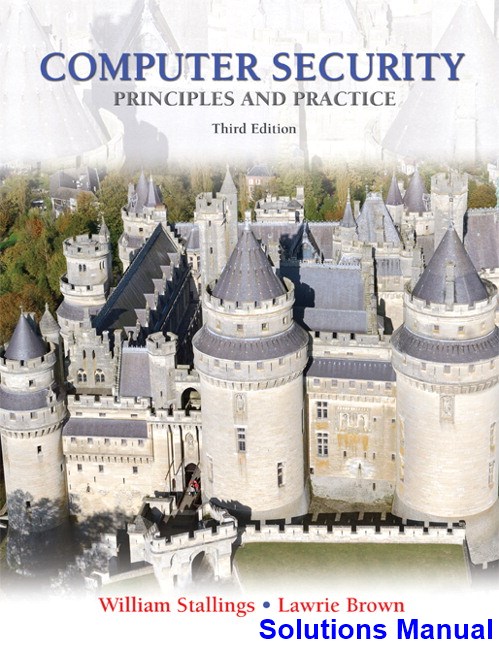
Product details:
- ISBN-10 : 0133773922
- ISBN-13 : 978-0133773927
- Author: Dr. William Stallings
Computer Security: Principles and Practice, Third Edition, is ideal for courses in Computer/Network Security. It also provides a solid, up-to-date reference or self-study tutorial for system engineers, programmers, system managers, network managers, product marketing personnel, system support specialists.
In recent years, the need for education in computer security and related topics has grown dramatically―and is essential for anyone studying Computer Science or Computer Engineering. This is the only text available to provide integrated, comprehensive, up-to-date coverage of the broad range of topics in this subject. In addition to an extensive pedagogical program, the book provides unparalleled support for both research and modeling projects, giving students a broader perspective.
Table contents:
Chapter 0 Guide for Readers and Instructors
0.1 Outline of This Book
0.2 A Roadmap for Readers and Instructors
0.3 Support for CISSP Certification
0.4 Support for NSA/DHS Certification
0.5 Support for ACM/IEEE Computer Science Curricula 2013
0.6 Internet and Web Resources
0.7 Standards
Chapter 1 Overview
1.1 Computer Security Concepts
1.2 Threats, Attacks, and Assets
1.3 Security Functional Requirements
1.4 Fundamental Security Design Principles
1.5 Attack Surfaces and Attack Trees
1.6 Computer Security Strategy
1.7 Recommended Reading
1.8 Key Terms, Review Questions, and Problems
PART ONE COMPUTER SECURITY TECHNOLOGY AND PRINCIPLES
Chapter 2 Cryptographic Tools
2.1 Confidentiality with Symmetric Encryption
2.2 Message Authentication and Hash Functions
2.3 Public-Key Encryption
2.4 Digital Signatures and Key Management
2.5 Random and Pseudorandom Numbers
2.6 Practical Application: Encryption of Stored Data
2.7 Recommended Reading
2.8 Key Terms, Review Questions, and Problems
Chapter 3 User Authentication
3.1 Electronic User Authentication Principles
3.2 Password-Based Authentication
3.3 Token-Based Authentication
3.4 Biometric Authentication
3.5 Remote User Authentication
3.6 Security Issues for User Authentication
3.7 Practical Application: An Iris Biometric System
3.8 Case Study: Security Problems for ATM Systems
3.9 Recommended Reading
3.10 Key Terms, Review Questions, and Problems
Chapter 4 Access Control
4.1 Access Control Principles
4.2 Subjects, Objects, and Access Rights
4.3 Discretionary Access Control
4.4 Example: UNIX File Access Control
4.5 Role-Based Access Control
4.6 Attribute-Based Access Control
4.7 Identity, Credential, and Access Management
4.8 Trust Frameworks
4.9 Case Study: RBAC System for a Bank
4.10 Recommended Reading
4.11 Key Terms, Review Questions, and Problems
Chapter 5 Database and Cloud Security
5.1 The Need for Database Security
5.2 Database Management Systems
5.3 Relational Databases
5.4 SQL Injection Attacks
5.5 Database Access Control
5.6 Inference
5.7 Database Encryption
5.8 Cloud Computing
5.9 Cloud Security Risks and Countermeasures
5.10 Data Protection in the Cloud
5.11 Cloud Security as a Service
5.12 Recommended Reading
5.13 Key Terms, Review Questions, and Problems
Chapter 6 Malicious Software
6.1 Types of Malicious Software
6.2 Advanced Persistent Threat
6.2 Propagation – Infected Content – Viruses
6.3 Propagation – Vulnerability Exploit – Worms
6.4 Propagation – Social Engineering – SPAM E-Mail, Trojans
6.5 Payload – System Corruption
6.6 Payload – Attack Agent – Zombie, Bots
6.7 Payload – Information Theft – Keyloggers, Phishing, Spyware
6.8 Payload – Stealthing – Backdoors, Rootkits
6.9 Countermeasures
6.10 Recommended Reading
6.11 Key Terms, Review Questions, and Problems
Chapter 7 Denial-of-Service Attacks
7.1 Denial-of-Service Attacks
7.2 Flooding Attacks
7.3 Distributed Denial-of-Service Attacks
7.4 Application-Based Bandwidth Attacks
7.5 Reflector and Amplifier Attacks
7.6 Defenses Against Denial-of-Service Attacks
7.7 Responding to a Denial-of-Service Attack
7.8 Recommended Reading
7.9 Key Terms, Review Questions, and Problems
Chapter 8 Intrusion Detection
8.1 Intruders
8.2 Intrusion Detection
8.3 Analysis Approaches
8.4 Host-Based Intrusion Detection
8.5 Network-Based Intrusion Detection
8.6 Distributed or Hybrid Intrusion Detection
8.7 Intrusion Detection Exchange Format
8.8 Honeypots
8.9 Example System: Snort
8.10 Recommended Reading
8.11 Key Terms, Review Questions, and Problems
Chapter 9 Firewalls and Intrusion Prevention Systems
9.1 The Need for Firewalls
9.2 Firewall Characteristics and Access Policy
9.3 Types of Firewalls
9.4 Firewall Basing
9.5 Firewall Location and Configurations
9.6 Intrusion Prevention Systems
9.7 Example: Unified Threat Management Products
9.8 Recommended Reading
9.9 Key Terms, Review Questions, and Problems
PART TWO SOFTWARE SECURITY AND TRUSTED SYSTEMS
Chapter 10 Buffer Overflow
10.1 Stack Overflows
10.2 Defending Against Buffer Overflows
10.3 Other Forms of Overflow Attacks
10.4 Recommended Reading
10.5 Key Terms, Review Questions, and Problems
Chapter 11 Software Security
11.1 Software Security Issues
11.2 Handling Program Input
11.3 Writing Safe Program Code
11.4 Interacting with the Operating System and Other Programs
11.5 Handling Program Input
11.6 Recommended Reading
11.7 Key Terms, Review Questions, and Problems
Chapter 12 Operating System Security
12.1 Introduction to Operating System Security
12.3 System Security Planning
12.3 Operating Systems Hardening
12.4 Application Security
12.5 Security Maintenance
12.6 Linux/UNIX Security
12.7 Windows Security
12.8 Virtualization Security
12.9 Recommended Reading
12.10 Key Terms, Review Questions, and Problems
Chapter 13 Trusted Computing and Multilevel Security
13.1 The Bell-LaPadula Model for Computer Security
13.2 Other Formal Models for Computer Security
13.3 The Concept of Trusted Systems
13.4 Application of Multilevel Security
13.5 Trusted Computing and the Trusted Platform Module
13.6 Common Criteria for Information Technology Security Evaluation
13.7 Assurance and Evaluation
13.8 Recommended Reading
13.9 Key Terms, Review Questions, and Problems
PART THREE MANAGEMENT ISSUES
Chapter 14 IT Security Management and Risk Assessment
14.1 IT Security Management
14.2 Organizational Context and Security Policy
14.3 Security Risk Assessment
14.4 Detailed Security Risk Analysis
14.5 Case Study: Silver Star Mines
14.6 Recommended Reading
14.7 Key Terms, Review Questions, and Problems
Chapter 15 IT Security Controls, Plans and Procedures
15.1 IT Security Management Implementation
15.2 Security Controls or Safeguards
15.3 IT Security Plan
15.4 Implementation of Controls
15.5 Monitoring Risks
15.6 Case Study: Silver Star Mines
15.7 Recommended Reading
15.8 Key Terms, Review Questions, and Problems
Chapter 16 Physical and Infrastructure Security
16.1 Overview
16.2 Physical Security Threats
16.3 Physical Security Prevention and Mitigation Measures
16.4 Recovery from Physical Security Breaches
16.5 Example: A Corporate Physical Security Policy
16.6 Integration of Physical and Logical Security
16.7 Recommended Reading
16.8 Key Terms, Review Questions, and Problems
Chapter 17 Human Resources Security
17.1 Security Awareness, Training, and Education
17.2 Employment Practices and Policies
17.3 E-Mail and Internet Use Policies
17.4 Computer Security Incident Response Teams
17.5 Recommended Reading
17.6 Key Terms, Review Questions, and Problems
Chapter 18 Security Auditing
18.1 Security Auditing Architecture
18.2 The Security Audit Trail
18.3 Implementing the Logging Function
18.4 Audit Trail Analysis
18.5 Example: An Integrated Approach
18.6 Recommended Reading
18.7 Key Terms, Review Questions, and Problems
Chapter 19 Legal and Ethical Aspects
19.1 Cybercrime and Computer Crime
19.2 Intellectual Property
19.3 Privacy
19.4 Ethical Issues
19.5 Recommended Reading
19.6 Key Terms, Review Questions, and Problems
Appendix 19A: Information Privacy Standard of Good Practice
PART FOUR CRYPTOGRAPHIC ALGORITHMS
Chapter 20 Symmetric Encryption and Message Confidentiality
20.1 Symmetric Encryption and Message Confidentiality
20.2 Data Encryption Standard
20.3 Advanced Encryption Standard
20.4 Stream Ciphers and RC4
20.5 Cipher Block Modes of Operation
20.6 Location of Symmetric Encryption Devices
20.7 Key Distribution
20.8 Recommended Reading
20.9 Key Terms, Review Questions, and Problems
Chapter 21 Public-Key Cryptography and Message Authentication
21.1 Secure Hash Functions
21.2 HMAC
21.3 The RSA Public-Key Encryption Algorithm
21.4 Diffie-Hellman and Other Asymmetric Algorithms
21.5 Recommended Reading
21.6 Key Terms, Review Questions, and Problems
PART FIVE NETWORK SECURITY
Chapter 22 Internet Security Protocols and Standards
22.1 Secure Email and S/MIME
22.2 DomainKeys Identified Mail
22.3 Secure Sockets Layer (SSL) and Transport Layer Security (TLS)
22.4 HTTPS
22.5 IPv4 and IPv6 Security
22.6 Recommended Reading
22.7 Key Terms, Review Questions, and Problems
Chapter 23 Internet Authentication Applications
23.1 Kerberos
23.2 X.509
23.3 Public-Key Infrastructure
23.4 Federated Identity Management
23.5 Recommended Reading
23.6 Key Terms, Review Questions, and Problems
Chapter 24 Wireless Network Security
24.1 Wireless Security Overview
24.2 Mobile Device Security
24.3 IEEE 802.11 Wireless LAN Overview
24.4 IEEE 802.11i Wireless LAN Security
24.5 Recommended Reading
24.6 Key Terms, Review Questions, and Problems
APPENDICES
Appendix A Projects and Other Student Exercises for Teaching Computer Security
A.1 Hacking Project
A.2 Laboratory Exercises
A.3 Security Education (SEED) Projects
A.4 Research Projects
A.5 Programming Projects
A.6 Practical Security Assessments
A.7 Firewall Projects
A.8 Case Studies
A.9 Reading/Report Assignments
A.10 Writing Assignments
A.11 Webcasts for Teaching Computer Security
REFERENCES
INDEX
LIST OF ACRONYMS
ONLINE CHAPTERS AND APPENDICES
Online chapters, appendices, and other documents are Premium Content, available via the access card printed in the front of the book.
Chapter 25 Linux Security
25.1 Introduction
25.2 Linux’s Security Model
25.3 The Linux DAC in Depth: Filesystem Security
25.4 Linux Vulnerabilities
25.5 Linux System Hardening
25.6 Application Security
25.7 Mandatory Access Controls
25.8 Recommended Reading
25.9 Key Terms, Review Questions, and Problems
Chapter 26 Windows and Windows Vista Security
26.1 Windows Security Architecture
26.2 Windows Vulnerabilities
26.3 Windows Security Defenses
26.4 Browser Defenses
26.5 Cryptographic Services
26.6 Common Criteria
26.7 Recommended Reading
26.8 Key Terms, Review Questions, Problems, and Projects
Appendix B Some Aspects of Number Theory
Appendix C Standards and Standard-Setting Organizations
Appendix D Random and Pseudorandom Number Generation
Appendix E Message Authentication Codes Based on Block Ciphers
Appendix F TCP/IP Protocol Architecture
Appendix G Radix-64 Conversion
Appendix H Security Policy-Related Documents
Appendix I The Domain Name System
Appendix J The Base-Rate Fallacy
Appendix K SHA-3
Appendix L Glossary
People also search:
computer security principles and practice 3rd edition ppt
computer security principles and practice 3rd edition solution manual pdf
computer security principles and practice 3rd edition solutions
computer security principles and practice 3rd edition
information security principles and practice 3rd edition
Instant download after Payment is complete
You may also like…
Solutions Manual
Computer Security Principles And Practice Global 3rd Edition Stallings Solutions Manual
Solutions Manual
Cryptography and Network Security Principles and Practice 7th Edition Stallings Test Bank
Information Technology
Computer Security Principles and Practice 3rd Edition Stallings Test Bank
Solutions Manual
Cryptography and Network Security Principles and Practice 7th Edition Stallings Solutions Manual
Related products
Solutions Manual
Solutions Manual
Accounting Volume 1 Canadian 8th Edition Horngren Solutions Manual
Solutions Manual
A+ Guide to IT Technical Support Hardware and Software 9th Edition Andrews Solutions Manual
Solutions Manual
Solutions Manual
Accounting Business Reporting for Decision Making 6th Edition Birt Solutions Manual
Solutions Manual




